

 The famous Kallur lighthouse on Kalsoy Island.
The famous Kallur lighthouse on Kalsoy Island.



 The famous Kallur lighthouse on Kalsoy Island.
The famous Kallur lighthouse on Kalsoy Island.
In the middle of the mighty North Atlantic Ocean lies a mysterious archipelago with stunning landscapes, mythical mountains and colourful villages hidden in deep green valleys. It's a place where sheep outnumber people, Mother Nature reigns supreme and legends about trolls and elves come to life.
 text: kathleen van bremdt - photos: sven hoyaux, graatje weber
text: kathleen van bremdt - photos: sven hoyaux, graatje weber
The Faroe Islands consist of 18 mountainous islands that spread out in an isosceles triangle between Norway, Scotland and Iceland. It is a 55-million-year old, pristine archipelago in the middle of the North Atlantic Ocean. It is a 2 hour and 15 minutes flight from Copenhagen. The flight time immediately indicates how isolated the country is. From the air, we see how the islands lie haphazardly in the ocean like a pile of bones. They are mountainous and rugged with metres-high steep cliffs and numerous deeply cut fjords. The total land area is a mere 1,400 square kilometres (which is 10 times smaller than Belgium) with a maritime economic zone of 274,000 square kilometres. About 50,000 people and 70,000 sheep live on the Faroe Islands. Those sheep have been grazing there for over a thousand years. Faroe Islands therefore not surprisingly means Sheep Islands. Since 1948, the Faroe Islands have been a self-governing nation under the sovereignty of Denmark. The Faroese have their own parliament, national anthem, flag and language. Often, they are in step with the mother country, sometimes not. For example, unlike Denmark, the Faroe Islands are not part of the European Union. The Faroese are a proud people who prefer to represent their own interests as much as possible. Only defence, foreign affairs and justice are still the responsibility of the Danish Crown.

We want to discover the islands on our own and at our own pace and hire a car at the airport. We end up in a tranquil landscape with mighty mountains, deep green valleys and villages with hobbit-like houses with turf roofs. After 45 minutes we arrive in the capital Tórshavn. We have to drive around for a while before we find our hotel, Hotel Føroyar , because it is completely absorbed in the surrounding landscape. At the hotel, we are welcomed by Ragnar Joensen and Oddmar Kruse, our two local Porsche owners with whom we had already made contact before our departure. It's nice to finally see each other in person and we immediately make the first appointments for the interviews and photo shoots. The names of the places that Ragnar and Oddmar suggest are impossible for us to remember, much less to pronounce. Faroese is a very special language. You may also stumble over the words when you read the report. The language is descended from Old Norse and has been around for a long time. However, it was not recognised as the official main language of the Faroe Islands until 1948. Danish is still the second official language. Fortunately for us, most Faroese speak excellent English.

We end up in a tranquil landscape with mighty mountains, deep green valleys and villages with hobbit-like houses with turf roofs.Hotel Føroyar, Tórshavn.


Tórshavn is the smallest capital in Europe. It is therefore more of a large village than a city and easy to explore on foot. Half of the total population of the Faroe Islands lives in or around the capital. Tórshavn literally means 'Haven of Thor', the god of thunder and lightning. There is never a lack of drama on the Faroe Islands. The harbour is the central and liveliest place in the city. Brightly coloured warehouses line the waterfront. Behind the facades are trendy coffee bars and eateries. Nearby is also the old city centre with narrow alleys and wooden, black tarred houses with colourful window frames and green grass roofs. The great thing about this piece of ‘back in time’ is that the 14th-century houses are still inhabited, although the owners now have to pay a lot of money to do so. But then you really do get to live in an open-air museum. The grass carpet on the roofs is a system that dates back to earlier times but is still in use because of its highly insulating properties. The big advantage of those green roofs is that they fit in perfectly with nature. We also walk past the parliament. The Løgting is one of the oldest parliaments in the world, dating back to the 9th century. Unlike other countries, it is not secured, and you can simply take a look inside. Those who love art can visit the local museum, which has regularly changing exhibitions by Faroese artists. The Faroese are very proud of their culture and have a highly developed art and music scene.
Hospitality as we know it is a concept that is still in its infancy in the Faroe Islands. Outside the capital you will hardly find any restaurants or bars anywhere. But the few restaurants that exist do deliver quality. Restaurant KOKS actually won two Michelin stars two years ago. Unfortunately, the top restaurant is closed during our stay. So we book a table in ROKS , the little sister of KOKS. 'Roks' means something like 'joke', a name that was chosen to indicate that the approach in this restaurant is less formal. We are not yet familiar with the names of the Faroese dishes and just pick a few. Faroese cuisine is unusual to say the least. Fermented lamb, wind-dried fish and sheep's head… they are not exactly things we are used to. What makes Faroese cuisine so special is the way fish and meat are preserved. Because the islands are so remote, it was vital in times when there was no refrigeration that food could be preserved as long as possible. The Faroese used a process called ræst for this. They let the meat dry in the open air, subjected to the North Atlantic wind, allowing a natural aging process to occur. One might think that this traditional method is no longer necessary in today's modern times, but the taste obtained by this process is so unique and characteristic that the method is still widely used. Lamb and beef, fish and poultry that have matured in this way are blessed with the special 'fifth taste' that exists alongside salt, bitter, sour and sweet. In Japanese this is called umami which means 'delicious taste'. It is a full flavour that gives a dish depth. Almost every house in the Faroe Islands still has its own hjallur – a shed for drying meat. Fish, too, are allowed to dry outside, tied in pairs at the tail fin and hung from the eaves.
Tórshavn literally means 'Haven of Thor', the god of thunder and lightning. There is never a lack of drama on the Faroe Islands.
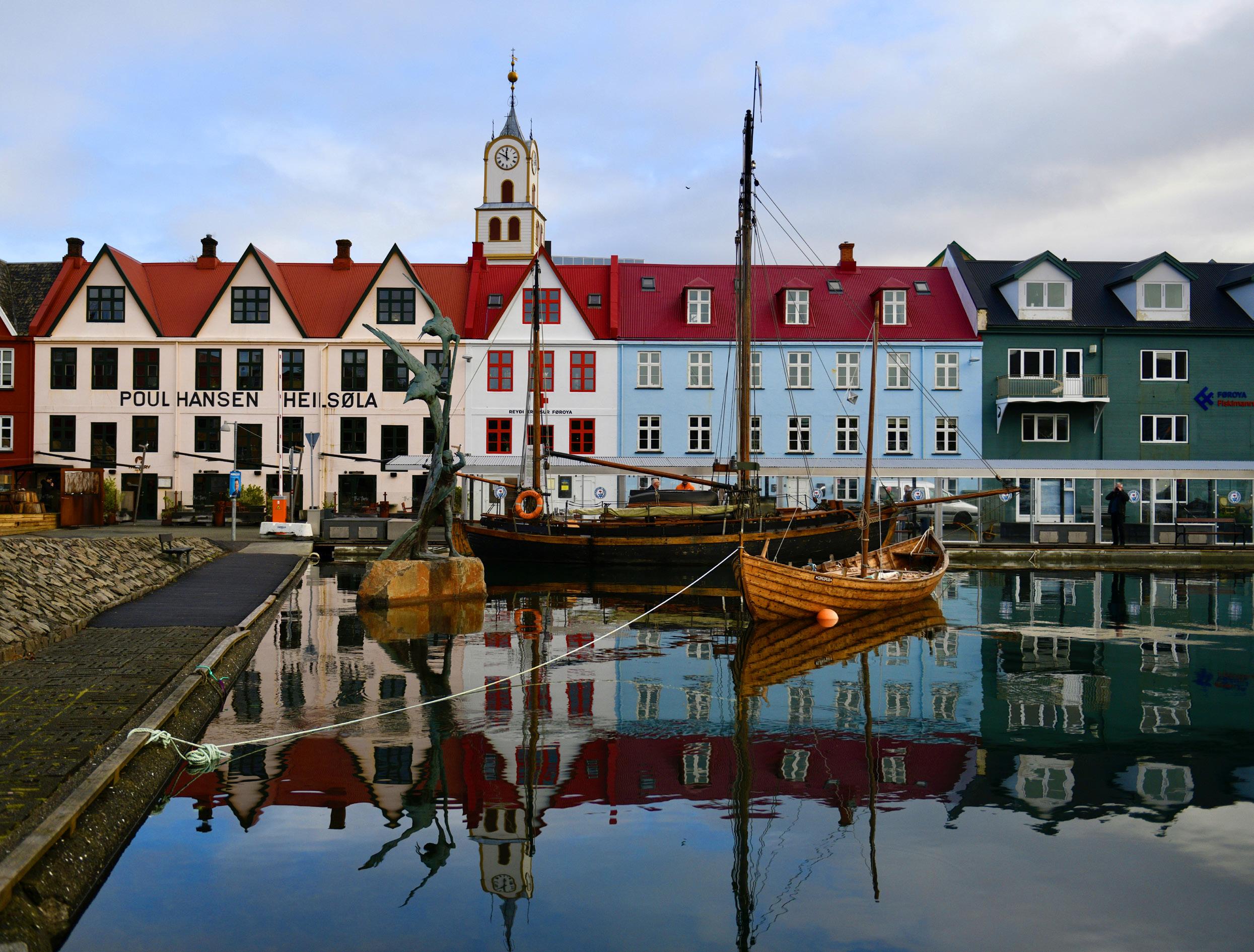

 The historical city centre from Tórshavn.
The historical city centre from Tórshavn.
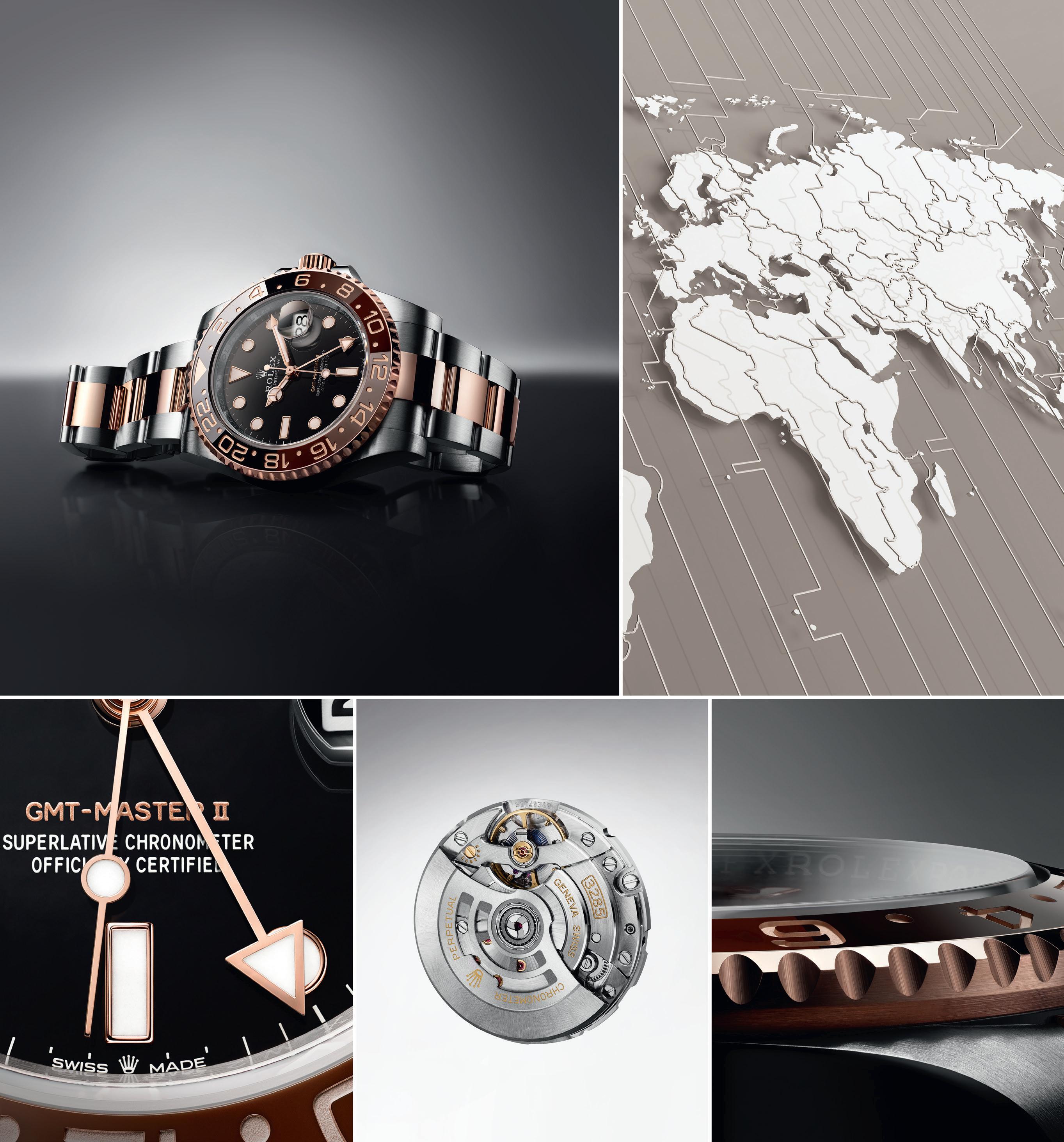










The first settlers on the Faroe Islands were Irish monks who settled in the Faroe Islands at the end of the 7th century, hermits who sought and found solitude among the countless seabirds. Two centuries later, the Vikings – the terror of Christian Europe at the time – set their sights on the Faroe Islands. The Vikings went down in history as bloodthirsty barbarians, but this image is too stereotypical, just as they did not wear helmets with horns and did not drink from skulls. However, not all Vikings were the same. Some travelled the world and were indeed very violent in their urge to conquer, others travelled to broaden their knowledge of the world. The Norsemen who set foot on the Faroe Islands came in peace and were out to build a new life. And that worked fine. They provided structure in society and started agricultural projects. Viking ruins can still be found on many islands in the Faroe Islands. What typified the Vikings was their decisiveness, ingenuity, quirkiness and strong bond with the sea and nature, qualities that are still clearly present in the DNA of today's islanders. The Faroese are shaped and moulded by the harsh elements that have surrounded them for generations, yet they are warm, generous and hospitable at the same time.

The weather in the Faroe Islands is one with a temperament that likes to assert itself. There is a subpolar maritime climate, which means cool summers, mild winters, abundant precipitation and strong winds. Doesn’t sound attractive? Just wait until you see the stunning landscapes these elements create. What characterises the weather here is its unpredictability and changeability. Clouds, sun, fog and rain showers alternate in rapid succession. In a few minutes a blue sky can turn into a grey fog bank, or it can rain on one side of the mountain while the sun shines on the other. Four seasons in one day: in the Faroe Islands it is commonplace. This is the reason behind their saying: 'If you don't like the weather, just wait five minutes.' In 1943, a British soldier living in the Faroe Islands wrote in his diary: ' Kanska ' is the Faroese word for ' maybe ' and the word that is most commonly used on the islands. Maybe we'll go fishing tomorrow, maybe we'll make hay, maybe we'll get married. All these things are only conditional, for maybe it will be too wet to make hay, or the sea will be too rough for fishing, or the storm will be too fierce for marriage. From which he concluded: this is The Land of Maybe . That’s a great title. We take it as it comes. After all, there is no such thing as bad weather, only inappropriate clothing and regardless of the weather, the clean air that is brought in from the ocean is a true blessing for our lungs.
We leave Tórshavn and drive to the neighbouring island of Vagar. The road network is excellent, and the islands are connected by an excellent network of mountain and sea tunnels, bridges, dams and ferries. If a place is really not accessible or a quick intervention is required, there is always the helicopter, a service that is subsidised by the government. We drive at a leisurely pace so that we have plenty of time to take in the surroundings. The rugged nature, the emptiness and the countless views make us forget time and space. Our heartbeat slows down and a peace descends on us that we haven't felt for a long time. The ocean is nearby everywhere. No place in the Faroe Islands is more than five kilometres from the water. The steep cliffs are irregularly shaped and take on all sorts of bizarre shapes. Our gaze falls on an imposing rock pillar that rises majestically from the sea. It is a 313-metre-high monolith, but according to the Faroese it is much more than that. Sagas, mythological stories and legends are inextricably linked to the islands. The spindly rock was named Trøllkonufingur , Trollwoman’s Finger. According to tradition, a witch had set her sights on Vagar and wanted to throw the island to Iceland one night. But she hadn't counted on the sun shining its warm rays on the troll at dawn, turning the woman to stone. As she plunged into the sea she clawed at the island one last time, her index finger sticking out of the water for eternity. It's not hard to imagine the jagged rock pillar as an old, crooked finger with weathered skin and a sharp, blackened nail.
From afar we hear the roar of the Múlafossur waterfall that starts as a modest river in the mountains, only to dive spectacularly into the ocean over the 60-metre-high cliff edge.
 The Múlafossur waterfall on Vagar Island.
The Múlafossur waterfall on Vagar Island.
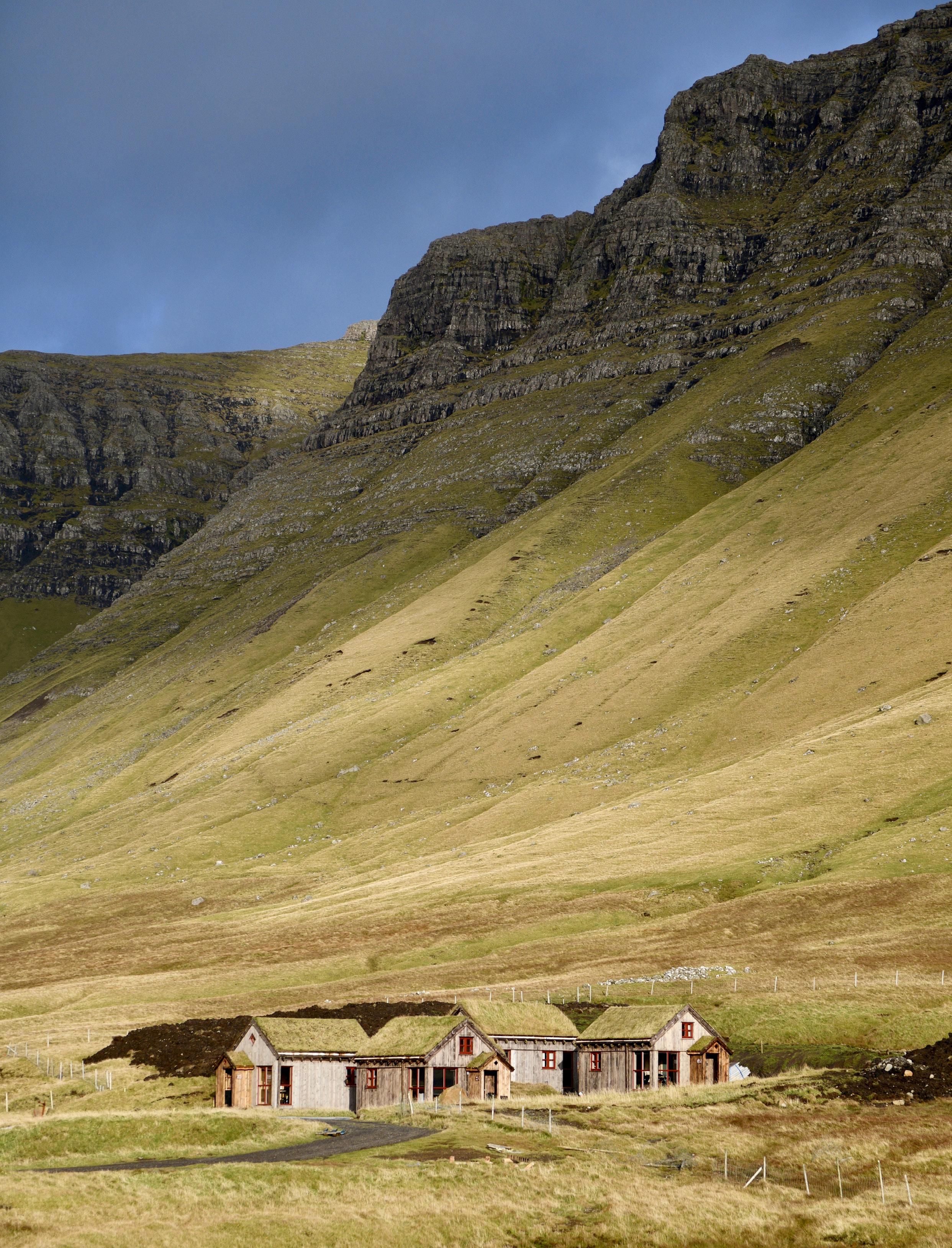
We take a break in Bøur . From here you have a spectacular view of the iconic Drangarnir rock formations that rise from the ocean like two altars. Remarkably, a car with a Dutch license plate stops. That arouses our curiosity, and we start talking to them. The young couple, Graatje and Juliette, have just spent six months in Iceland. Graatje is a professional drone photographer and enthusiastically shows us some of the beautiful photos he has taken. “We still have a few more days to explore the Faroe Islands and then, unfortunately, we will have to go back home,” says Juliette. We say goodbye and wish them a safe return to the Netherlands.
We follow the coastal road to the extreme western tip of the island and end up in Gásadalur , a tiny village located in an immense green valley surrounded by high basalt rocks. The village is situated a lot higher than the coastline, so that the view of the ocean extends endlessly. From afar we hear the roar of the Múlafossur waterfall that starts as a modest river in the mountains, only to dive spectacularly into the ocean over the 60-metre-high cliff edge. The village with its thirty inhabitants was for a long time one of the most isolated villages in Europe. Only in 2006 was a narrow one-lane tunnel constructed to connect Gásadalur with the rest of the island. Before that, the village could only be reached via the mountain pass that the postman took. Adventurous hikers sometimes venture on the tough climb in the summer, but it is a dangerous route with many height differences and close to the cliffs. We stay in one of the four Múlafossur Cottages: a small, cosy wooden guest house with all comforts. Only untouched nature surrounds us. It's like we're at the end of the world, the hide-away of dreams.
Islands are always partly dependent on the mainland. It is no different in the Faroe Islands. Yet the archipelago also has its own sources of income. Fishing is the most important of these. Fish and fish products make up more than 97% of the total export volume. The many sheep are also important. They provide 60% of meat production and are loyal suppliers of wool. Tourism occupies only a modest place, which is remarkable for an island group that was named Most Appealing Island in the World by National Geographic Traveller in 2007, leaving more than 100 coconut paradises and big names far behind. And that's how the Faroese want to keep it. They absolutely do not want to become a second Iceland. Tourists are sensitised to treat the country and the beautiful fauna and flora with respect.
The weather in the Faroe Islands is very unpredictable and changeable. Four seasons in one day is commonplace.
In addition to catching fish, fish is also farmed on the Faroe Islands, with especially salmon doing very well in the Faroese waters. In several fjords we see large circles in the water that indicate the top of a salmon basin. We visit Hiddenfjord , a salmon farm regarded by many fish buyers, chefs and consumers from around the world as one of the very best. We are welcomed by the marketing manager, Levi Hanssen. The roots of Hiddenfjord go back to 1887. The current owners – brothers Atli and Regin Gregersen – are the great-grandchildren of the founder. “The fact that Hiddenfjord is still a family business has many advantages,” says Levi. “This gives us the freedom to continuously develop new ideas and practices without feeling the hot breath on our necks of shareholders who are often only interested in short-term profit.” Levi gives us an extensive presentation in which the cultivation, harvesting and processing process of the salmons is explained from A to Z. Why does salmon thrive so well in the Faroe Islands? we want to know. “Because of the weather conditions that are ideal for the Atlantic salmon, Levi explains. “It gets too hot in Scotland in the summer and too cold in Norway and Iceland in the winter. In the Faroe Islands, the temperature of the water remains between 6 and 10 degrees all year round. The rough weather with lots of wind and rain is also an advantage. Salmon like water that has movement so that there is always a lot of oxygen.” One of the company's most important values is sustainability and at Hiddenfjord they put their money where their mouth is. Under the slogan 'Salmon should swim, not fly', the company completely stopped using air transport on November 10, 2020. “With this step, we have taken a decision that is unprecedented in a global food industry that too often talks the talk but takes little real action to protect the environment,” Levi explains with pride. “In the meantime, it has become clear that sea transport is much better for preserving the quality of our salmon. With transport by ship, we have much more control over the temperature during transport than with air transport.” So nothing but advantages.


Due to a process called ræst – drying in open air –meat and fish are blessed with the special 'fifth taste' that exists alongside salt, bitter, sour and sweet.
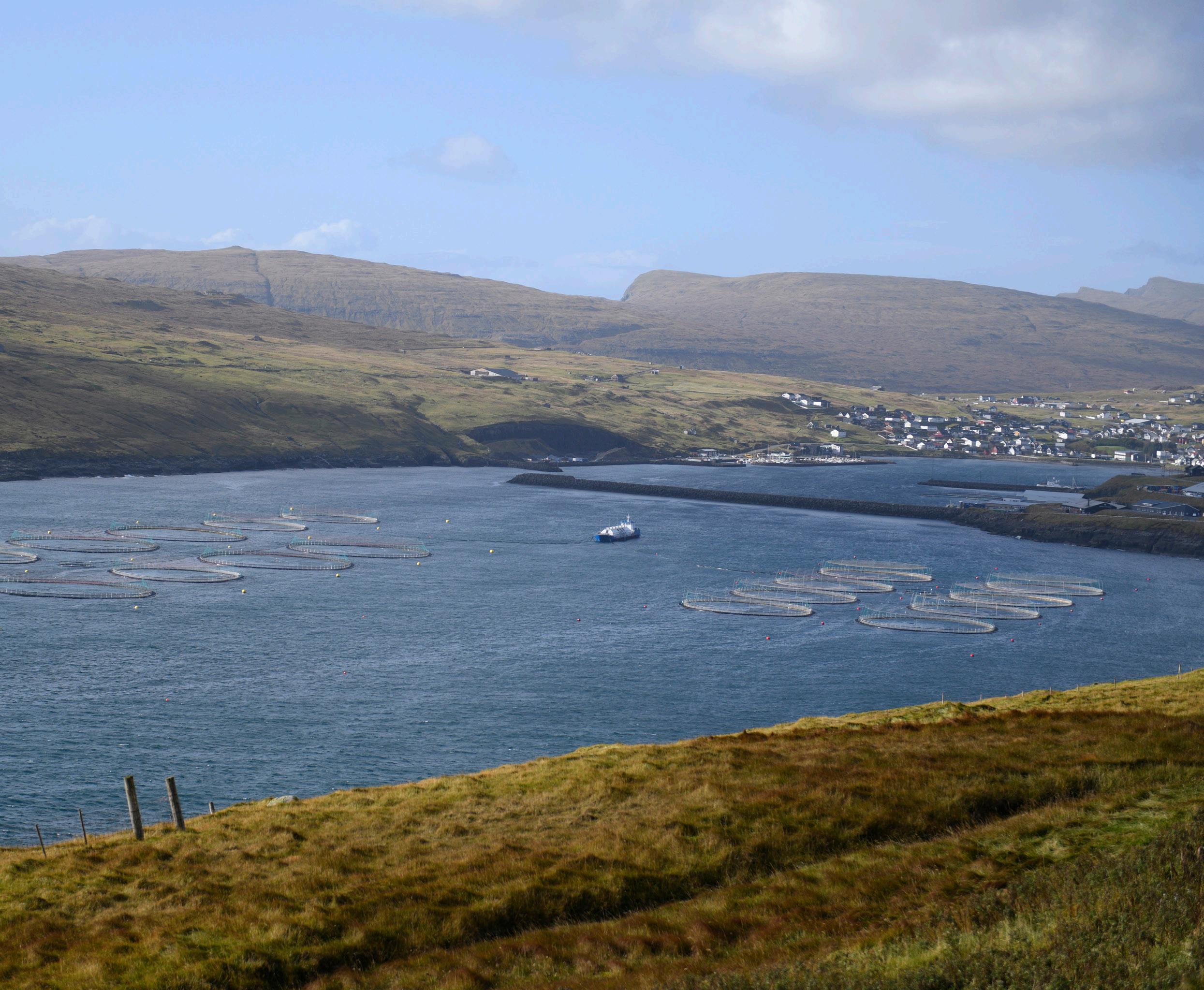 The weather conditions on the Faroe Islands are ideal for the Atlantic salmon.
The weather conditions on the Faroe Islands are ideal for the Atlantic salmon.
The Norðadalsskarð, a spectacular mountain pass that winds its way into the Norðradalur Valley for 2.4 kilometres, is a dream for every driver who likes to have fun behind the wheel of a car.

It has been raining all day, but when we step outside Hiddenfjord the sun suddenly breaks through. “Time for a Porsche shoot!” is the first thing that crosses our minds, and we immediately send a message to our two Porsche fanatics. We can't get hold of Ragnar, but we manage to reach Oddmar. We agree to meet at Norðadalsskarð , a spectacular mountain pass that winds its way into the Nororadalur Valley for 2.4 kilometres. The many hairpin bends are a dream for every driver who likes to have fun behind the wheel of a car. Oddmar’s red 964 is a feast for the eyes in this beautiful setting. Miraculously, the Dutch couple also turns up just at that moment. There is no such thing as coincidence, right? Graatje is wildly enthusiastic and immediately brings out his drone. A photo from the air makes the picture even more spectacular. “I will forward this photo to my father tonight,” says Graatje. “He is an ardent Porsche enthusiast and when he sees these pictures he is guaranteed to go crazy.”

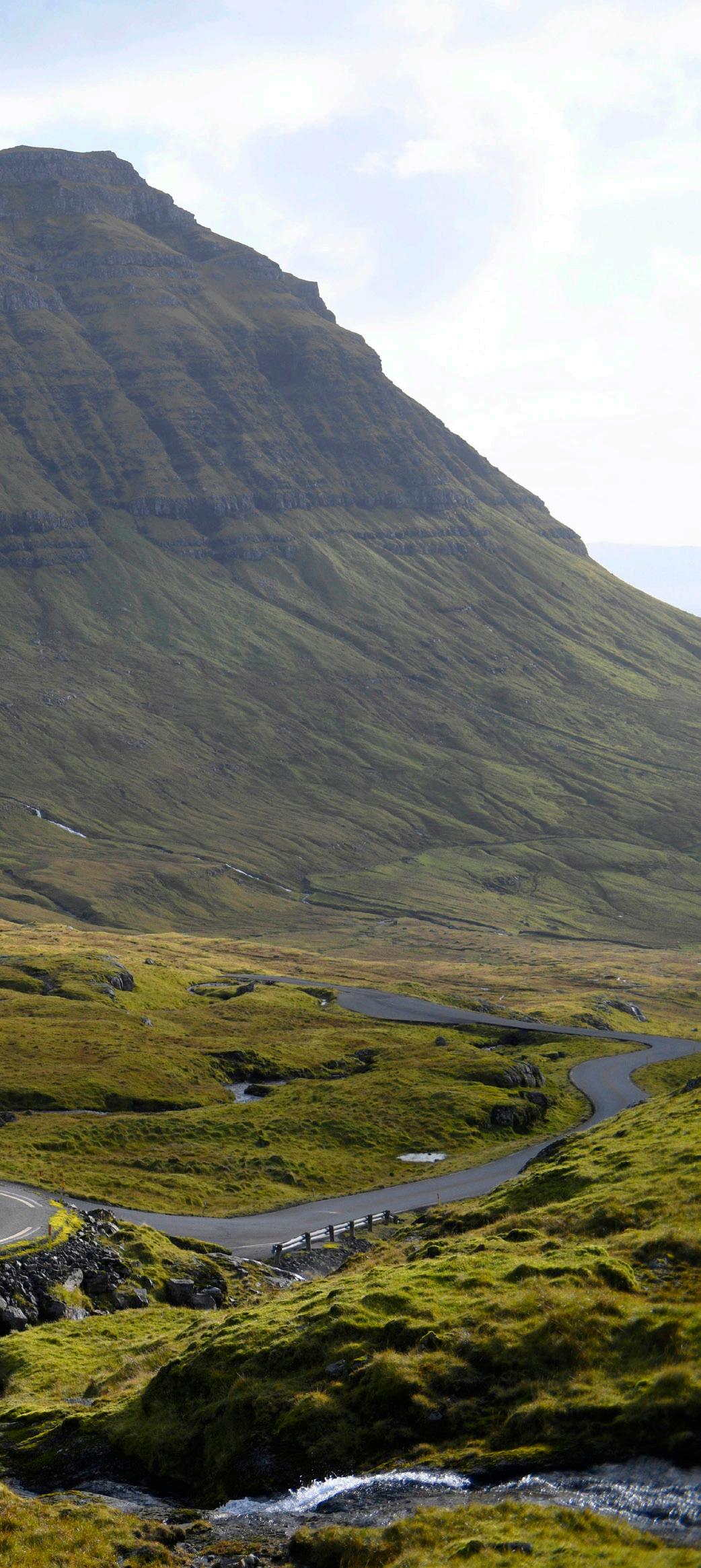

Wherever you are, you will see sheep everywhere, accurately numbered and all individually owned. They come in all colours, shades and patterns. Their small eyes look like marbles, and they look at us imperturbably. Thanks to the sheep, people have lived on the Faroe Islands for centuries. There are few other animals that can make do with only grasses and dwarf shrubs. Because of the strong wind that constantly blows a salty mist over the rocks, only the toughest plants survive here. Normally there are about 70,000 sheep, but now that the slaughtering season is coming to an end, that number has been reduced by a third. Slaughtering is still a collective activity in the Faroe Islands. Of course there are professional sheep farmers, but once it's slaughter time, every extra hand is welcome. As a Faroese you may be an accountant or vacuum cleaner seller in everyday life, but when it comes down to it you still know how to skin an animal. The meat is for export as well as for own use. It is generously shared with neighbours and family so that everyone has a good supply to get through the winter.
And then of course there is also the fantastic wool that the animals give so selflessly. The wool of the Faroese sheep is double coated with a very fine inner coat and a rough long-haired outer coat. That gives many possibilities. An old Faroese proverb says 'Ull er Føroya gull' which means 'wool is Faroese gold', an idea that can be traced back to earlier times when wool and woollen clothing were the only currency of the islanders and knitwear was exchanged for salt, sugar, coffee and other necessities.
Knitting is still very popular in the Faroe Islands and in recent years Faroese sweaters, hats and scarves have even found their way into the international fashion world. Sissal Kristiansen is one of those people who combines traditional patterns and techniques with new designs and styles to create her own brand Shisa Brand . “I feel inspired by the mystical Faroese nature with its fog and muted colours and the rugged beauty of the landscape,” says the designer. “The colour of the yarn is determined by the colour of the wool, which can be white, grey, beige, warm red-brown, chestnut brown, black or a mixture thereof.” Despite the worldwide success, Sissal does not mass-produce. Each item is still made by hand. In her studio we also meet Barbara Carlsen , a friend of Sissal's who often serves as a model for her designs. “I also knit occasionally,” she says, “but I’m not in the same leagues as Sissal. My great passion is horse riding. I've been riding since I was seven. My boyfriend and I currently have five horses together. They take up a lot of our time, but it's a lifestyle. I like the rough life on the islands. There is no greater sense of freedom than galloping on horseback over the hills and meadows here. And I like going pretty fast. As a young teenager I already started racing in competitions. This year I won the national championship, just like in 2020. I am quite proud to be the fastest rider in the Faroe Islands.”

The Faroese are shaped and moulded by the harsh elements that have surrounded them for generations, yet they are warm, generous and hospitable at the same time.Barbara Carlsen, the Faeroese's fastest horse rider. (Image Harald Bjørgvin)
 Barbara Carlsen in a jumper by Faroese designer Sissal Kristiansen. (Image Shisa Brand)
Barbara Carlsen in a jumper by Faroese designer Sissal Kristiansen. (Image Shisa Brand)



We drive north over the Streymin Bridge that connects the island of Streymoy with neighbouring Esturoy. On the side of the fjord, fishermen stand motionless like statues in the pouring rain. They won't budge until they get a bite. In Æðuvík, a village on the southernmost tip of Eysturoy, we spend the night with Harriet and John, who have built a fantastically beautiful guest studio adjacent to their house: ultramodern with lots of light and an unobstructed view of the sheep pastures with the ocean beyond. A line of ducks waddles past, unabashedly tapping their beaks against the window. “We once had guests who fed them,” Harriet laughs, “and they've been trying their luck ever since.”

We are invited for a so-called heimablídni (literally translated: 'hospitality at home'). A heimablídni is not just a dinner party. It is typically Faroese and something you have to experience to understand. It is a meal with a soul, in people's homes, where only traditional, home-made Faroese dishes are served, and you become part of the Faroese culture. While one steaming dish after another appears on the table, our hostess and host talk a lot. “Our house is the second oldest house in the village. It dates back to 1898. We bought it in 2014 and completely renovated it with as much attention as possible to the original,” says John. “We even repainted it in its original colours. It is mainly the location of the house that was the deciding factor, because Harriet dreamed of a sheep farm”. “I've always had a love for sheep,” Harriet agrees. “My father was not very pleased with me becoming a sheep farmer. It's still more of a man's job, but I grew up on a farm and can hold my own. I learn by trial and error. Sheep are intelligent animals. They know exactly on which terrain to graze, as if the coordinates are passed on with their mother's milk. They are creatures that are content with what they have, and I think that's a very nice quality.”

Harriet is a jack-of-all-trades. In our studio we have seen artful photos she has made of animals and landscapes. “Yes, that is a hobby that got somewhat out of hand,” she laughs. “I bought a camera from my brother and started experimenting. Around here you can take so many beautiful pictures. My photos of sheep and horses with a floral crown on their head are particularly successful. I posted the photos on Instagram and got a lot of positive reactions.” Harriet now has the photos printed on calendars, posters, mugs and T-shirts and sells them locally or through her website. The business is very successful. “That's Harriet all over,” says John proudly. “She's brimming with ideas. She starts something and then sees where it takes her. And it always takes her somewhere. The studio is already being used for all kinds of creative workshops.”

The next day Harriet takes us to the horses that are stabled a little further on. Faroese horses are a separate breed. They are smaller than a horse, but larger than a pony. It's incredible how Harriet treats animals. Whether it be the horses, the sheep, the dogs, the ducks, the chickens or the cats: she likes them all equally. And the love is mutual, we notice, because when she is around, they do not leave her side. “This is my life,” she says, looking around with satisfaction. "Work hard but enjoy every day."
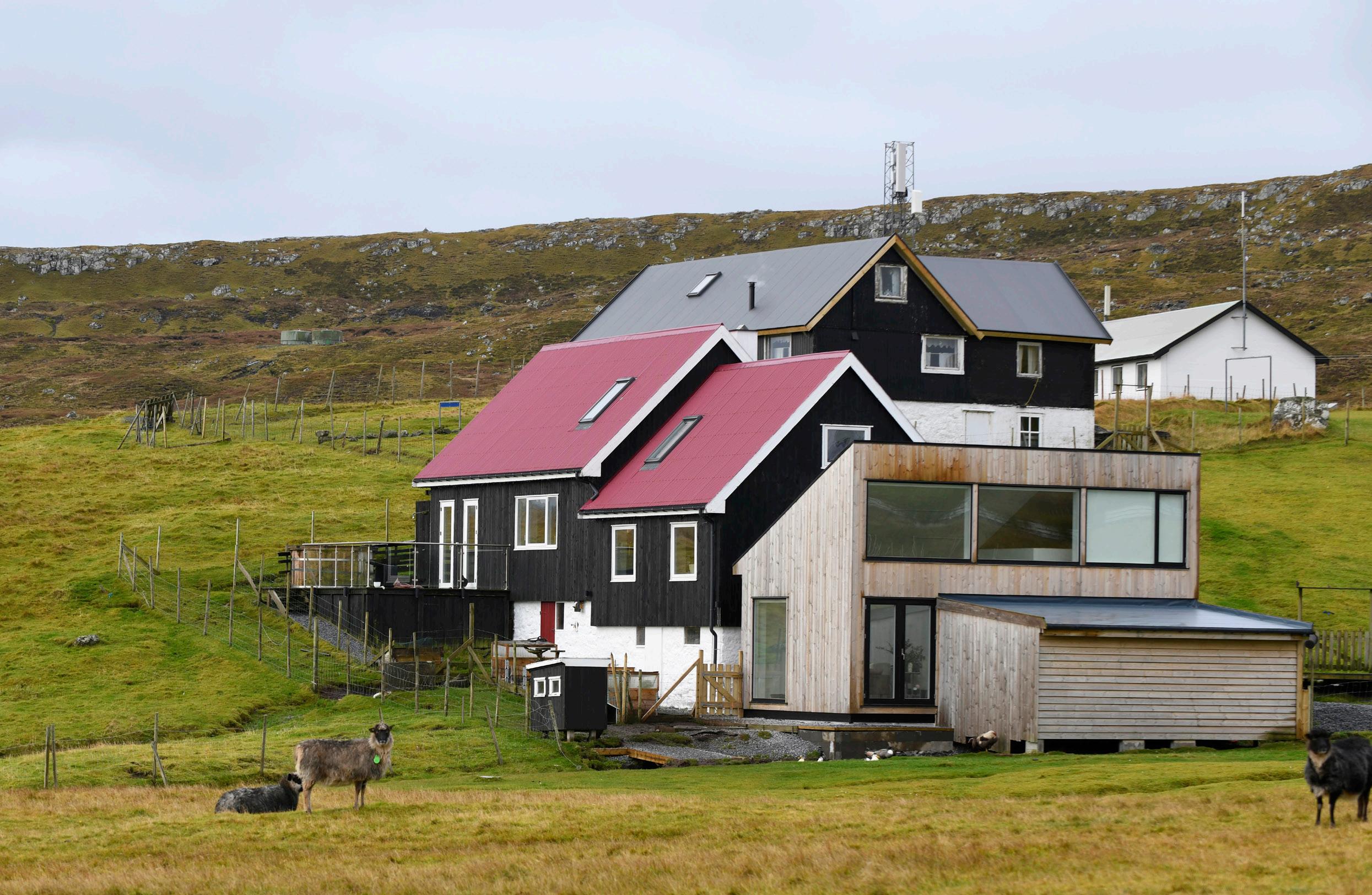 Hanusarstova, a guest house with a soul in Æðuvík on Eysturoy Island.
Hanusarstova, a guest house with a soul in Æðuvík on Eysturoy Island.
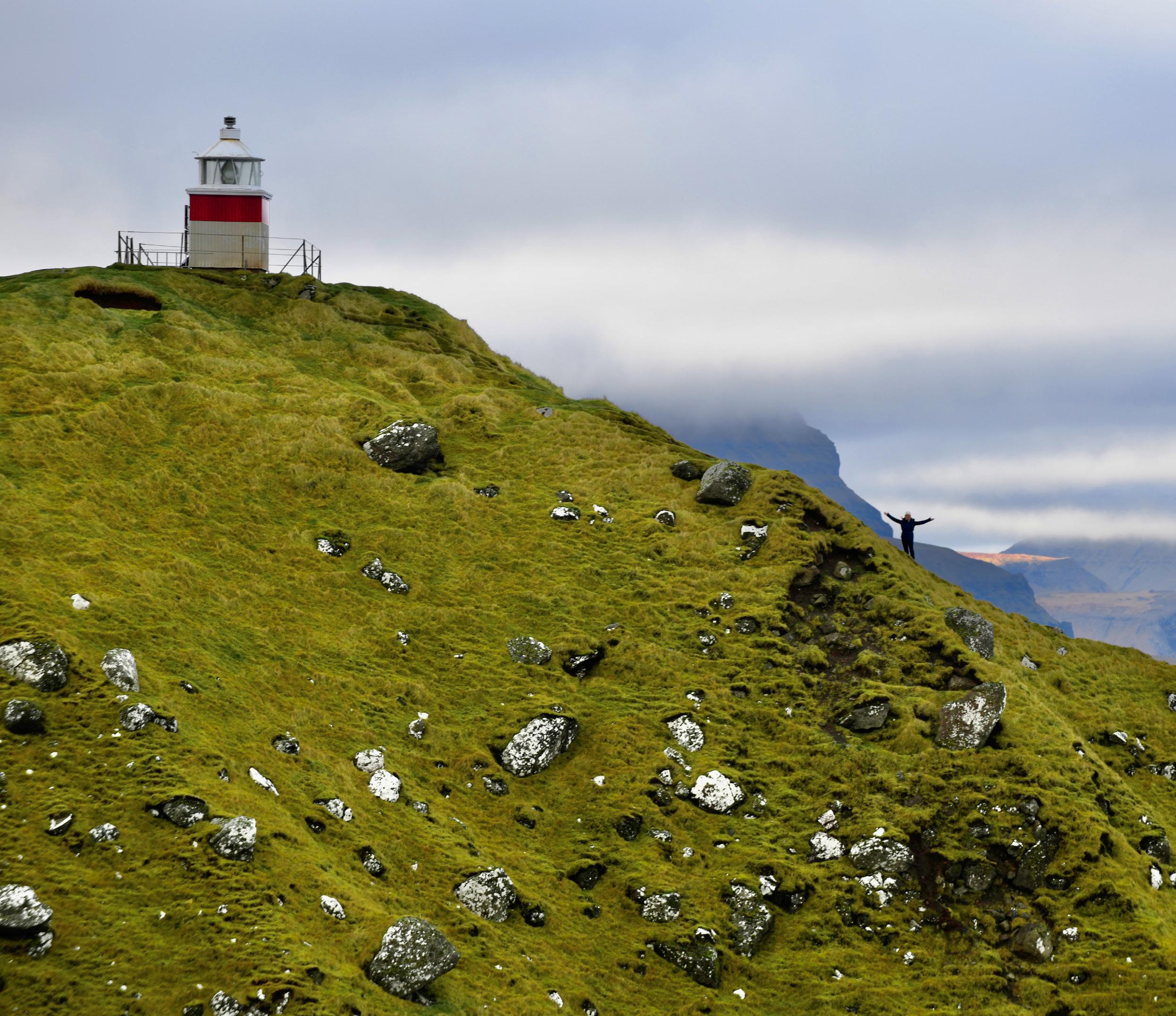


We move further north to the island of Kalsoy. No tunnel or bridge here, but a ferry. We were advised to be at the ferry in good time because the boat can only accommodate twelve cars and you cannot make reservations. We're lucky and are just able to get on. Today we are accompanied by a guide. Rani is already on board and walks towards us. He is like many Faroese: a little reserved and warm at the same time. It is an exceptionally beautiful morning, almost windless with a clear sky and the view from the fjord to both banks is phenomenal. The sun polishes the water, and the mountain sides are bathed in gold, yellow and green.
Kalsoy is an island of barely 30 km2 and 95 inhabitants spread over four villages. To connect these villages, four tunnels have been built on the 12 kilometre-long and only road on the island. It earned Kalsoy the nickname 'the flute'. The tunnels have only one lane and are roughly carved into the rock. After the last tunnel the road ends in the town of Trollanes . Such a name can only mean that we can expect some adventure. The most iconic spot on the island is the Kallur lighthouse which stands atop a cliff and marks the northernmost point of the island. Rani goes ahead of us. In the Faroe Islands, there are hardly any paved paths. We can only distinguish vague lines in the grass, traces of walkers who have preceded us. The mossy ground is soggy which makes climbing difficult. Meanwhile, the weather has turned and the first raindrops are falling. Perhaps Rani thinks the inclement weather is the ideal time to tell about the Huldufólk , the hidden people, mythological creatures who live here in the mountains and can suddenly appear. “Basically they are good-natured,” says Rani, “but if we disturb their home we will not survive.” Superstition, our mind says, but still, when it is night and the wind howls across the endless plains, you’ll probably think differently about this.
Rani shows us the spot from where we can take the most beautiful photo of the lighthouse. It is located at the very end of an opposite cliff. Someone with a fear of heights will immediately turn around here. Even though the wind is now almost blowing us over, we still venture on to the narrow path. We are rewarded with an immense panorama of the ocean and the surrounding islands. Behind us the lighthouse stands like a red and white beacon in the landscape. “Here you only hear the wind, the sea and the birds,” says Rani, “the sound of diamonds.”
Not only we are impressed by this phenomenal landscape, but so were the makers of the last James Bond film No Time to Die . In their search for the perfect location for the final scene of the film, they ended up right here on Kalsoy. A crew of sixty production people worked for weeks to transform the place into a futuristic missile base using scanning and all kinds of assembly and trucking techniques. The host of the crew was the young local farmer Jóhannus. He owns a large part of the land on which the recordings were made. After the release of the film, he came up with the idea of having a gravestone made and placing it exactly on the spot where Bond dies in the film. The stone bears the inscription 'In Memory of James Bond, 1962-2021. The Proper Function of Man Is to Live, Not to Exist.’ We may never get closer to Daniel Craig.

We bring Rani back to the ferry and drive to Mikladalur, with fifty inhabitants the largest of the four villages on Kalsoy. We have rented a house here through Airbnb. The owner sends us a message that the key is in the mailbox. The interior clearly shows that he normally lives here himself. Many family snapshots hang on the walls and the kitchen cupboards are well stocked. We peek into the adjacent barn and see six sheep carcasses hanging there. Yep, someone lives here. We also immediately know where the special smell that hangs in the house comes from. There are no shops on Kalsoy, so we did our shopping in Tórshavn beforehand. While fresh soup simmers on the stove, we look out from the living room. Another beautiful pastel painting is created in the air. For a fleeting moment we have the feeling that we really live here, in this fantastic place in the world.
The main attraction of Mikladalur is the statue of Kópakonan, the seal woman. Of course another strong legend forms the base for this statue. The story is too long to explain in full, but the curse that the woman placed on the men of Mikladalur after the suffering inflicted on her states: “There will be revenge, revenge on the men of Mikladalur. Some will die at sea and others will crash from the cliffs, until so many have died that they can stretch hand in hand around the shores of Kalsoy!” Well, on Kalsoy – and by extension all of the Faroes –occasional accidents do happen. The elements are so merciless that everyone in the Faroe Islands knows someone who has drowned at sea or suffered an unfortunate fall from a treacherous cliff. Some see this as a sign that there have not yet been enough casualties to lift the seal woman's curse. In any case, the legend has produced a beautiful image of a shapely woman who rises from the water like a goddess. The bronze statue is 2.6 metres high and has already weathered the heaviest storms. Kudos to the makers, we think. Proof that Kópakonan has magical powers, the Faroese think.
Sagas, mythological stories and legends are inextricably linked to the islands.The statue of the mythical Seal Woman.

Wonders can be found on the Faroe Islands not only in nature, but also underground. On our way back to Tórshavn we drive through the Eysturoyar tunnel , which opened in 2020. It is the longest undersea tunnel in the Faroe Islands at 11.3 kilometres and the only tunnel in the world with a roundabout in the middle . The tunnel is Y-shaped and connects the main island of Streymoy with two parts of the island of Eysturoy. At the roundabout, one branch goes west and another one goes east. Thanks to this ingenious tunnel construction, the travel time from the capital to the two cities on the neighbouring island is only fifteen minutes, while it used to take at least an hour. As if the roundabout itself wasn't spectacular enough, the designers wanted a ride through the tunnel to become a total experience. Local artist Tróndur Patursson was commissioned to give the roundabout an artistic appearance. Around the giant central pillar on the rotunda, an eighty-metre-long steel sculpture depicts life-size silhouettes of people performing a traditional Faroese ring dance. When you pass the roundabout, the figures seem to move. The whole is put in the spotlight with special light effects in bright colours. We drive there again two days later, early on a Sunday morning, to take pictures with a Porsche. We can do that thanks to Joanes Hansen, a Porsche owner who contacted us on his own initiative when he heard that we were making a report for a Porsche magazine. His black 911 Carrera 4 in the extraordinary decor of the tunnel is of course the icing on the cake for us.
 An impressive artwork adorns the roundabout in the Eysturoyartunnel.
An impressive artwork adorns the roundabout in the Eysturoyartunnel.
The artwork in the tunnel intrigues us and we want to know more about it. We visit Patursson whose studio is located in the harbour of Tórshavn, a large space that he shares with his son Brandur who inherited his father's genes and is also an artist. Patursson senior is now 76 and with his wild hair and inscrutable gaze, he looks like someone who lives in another universe. In addition to being a sculptor, he is also a painter and glass artist. There are countless works by him in the studio and we take the time to admire them. We ask about the significance of his work in the tunnel. The circle consists of 86 figures. “They symbolize the Faroese idea that by joining hands and working together we can achieve great things. At the same time, they are a tribute to our ancestors to whom we owe so much,” says the artist. Just like his father, Brandon likes to work with glass, but in a completely different way. He experiments with the so-called slumping technique in which glass is melted over a mould in a special oven, which leads to enigmatic shapes. Below them, he plays films that he has edited himself. The whole thing has a very hypnotic effect. In this studio, imagination and creativity know no bounds.


The Eysturoyar tunnel, which opened in 2020 is the longest undersea tunnel in the Faroe Islands at 11.3 kilometres and the only tunnel in the world with a roundabout in the middle.79-year-old Tróndur Patursson is the Faroe Islands' best-known artist.
The Faroe Islands: we may think that it is all peace and quiet, far from all the violence of war and international conflicts, but we are missing the point here, because the Faroe Islands are not as out of the picture as we think. Even though the nearest neighbouring countries may be hundreds of kilometres away, the Faroe Islands are strategically very well located in the shipping route between the two richest continents in the world and they – and their enemies – are well aware of this. When Germany occupied Denmark in 1940, the British promptly sent 8,000 soldiers to the Faroe Islands to ensure that the archipelago remained out of the hands of the Germans and to secure the important North Atlantic sea routes.
More than ten kilometres from Tórshavn, a former secret NATO military base, built during the Cold War, is still located on a 749-meter-high mountain plateau. The only thing visible from the outside are the two white domes that covered the radars. After the fall of the Berlin Wall, activities were systematically reduced, and the base closed in 2007. However, now that the threat from Russia is increasing again, there are concrete plans to put the installation back into use. Oddmar Kruse takes us up the mountain. You can read elsewhere in this magazine how it is that our Porsche man has the key to this old base. We glide up in a narrow elevator. We feel like miners. Upstairs we discover a large command centre with several floors. 150 soldiers once lived and worked here. First Americans, then Danes. A mini town in a mountain bunker. Agent 007 may be dead, but this all has a very high Bond content. The rooms have been vacated, but the infrastructure is in top condition. We can imagine that it won’t take that much time and effort to make this station operational again. We step outside through a small door. The view from the mountain is spectacular. Oddmar tells us that on a clear day you can see almost all the islands of the archipelago from this spot, but even on a drizzly day like today where the fog hangs low and the mountain peaks just poke out of the clouds, the view is equally spectacular.

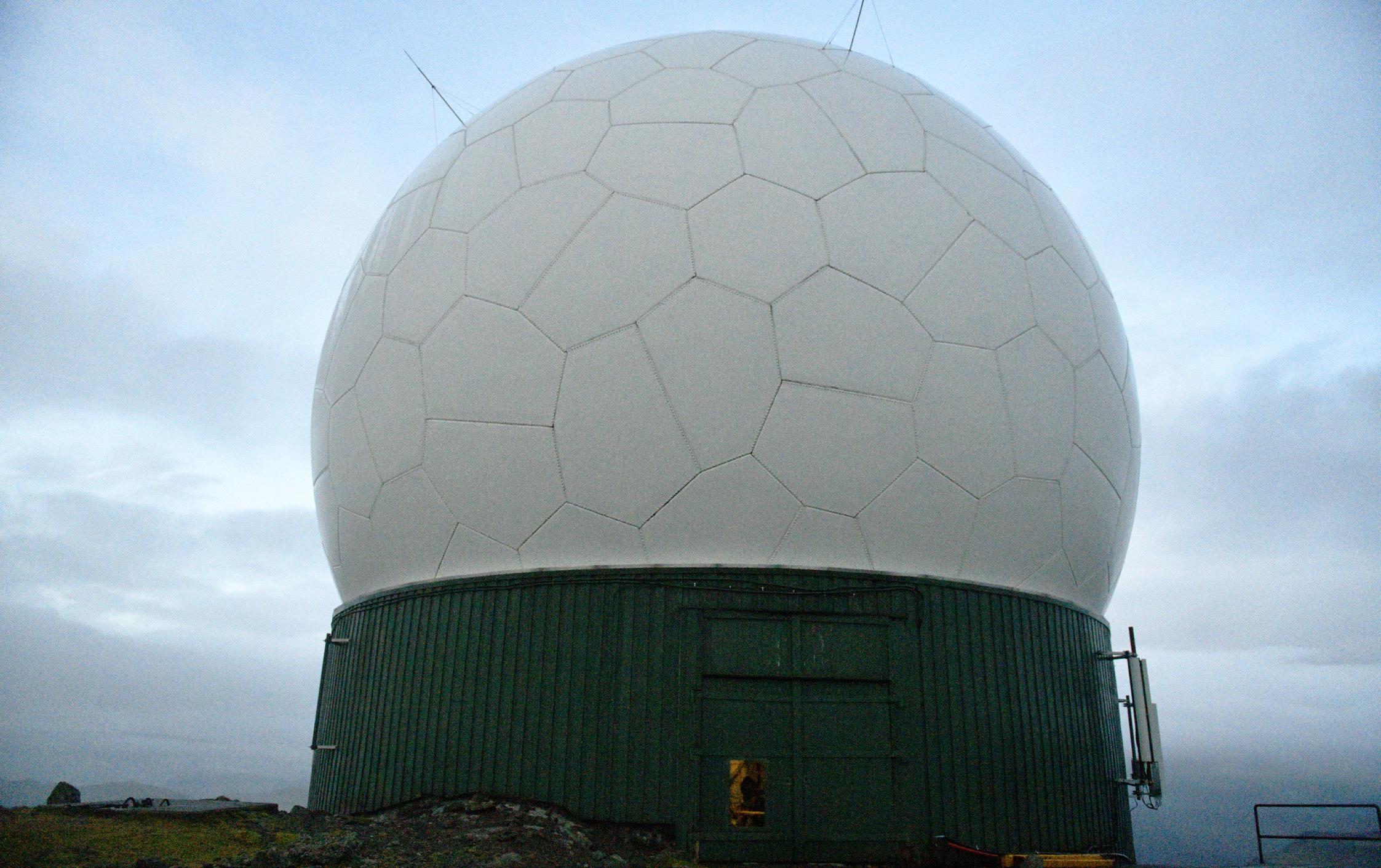


So much natural beauty, such freedom, such a remarkable society: once home we cannot stop talking about the Faroe Islands. The islands have touched us to the depths of our souls. In the Faroe Islands – where the weather determines the shutter speed of the days – infinite love for nature, social commitment, respect for traditions and modern development go hand in hand. ♦
With thanks to :
- Oddmar Kruse, Ragnar Joensen and Joanes Hansen, Porsche owners
- Stefan Heijtz, the Porsche locater from Sweden
- Tourist Board of the Faroe Islands, Marta Káradóttir
- Nordic Travel, www.nordic.be

- Hotel Føroyar, www.hotelforoyar.com
- Harriet en John, www.hanusarstova.com
- Hilton Garden Inn Faroe Islands, Mr. Torstein Christiansen, www.hiltongardeninn.fo
- Levi Hanssen, Brand & Marketing Manager Hiddenfjord
- Barbara Carlsen & Sissal Kristiansen, the model & the Brand Director from Shisa, www.shisabrand.com
- Graatje Weber and Juliette Van Montfort, drone specialists






hey have a lot in common: the same education, a technical career in aviation, lived abroad and a passion for Porsche. These two Faroese only met five years ago, but they became friends right away. It's difficult to do otherwise when you have so many similar interests.
text: kathleen van bremdt - photos: sven hoyauxYou are both from the Faroe Islands, but have both lived abroad a lot. How did that happen?
Ragnar: I was born in the Faroe Islands, but my parents moved to Greenland when I was three years old. That was in the early 1970s. Greenland was then in full expansion and there were many interesting job opportunities. My father was an aircraft mechanic and helped build the aviation infrastructure. After eleven years we returned with the family. A few years later I went back to Greenland for work. In 2001, I moved to Sweden where I stayed for almost twenty years. I had a job in aircraft maintenance management by SAS, Scandinavian Airlines.
Oddmar: I was also born in the Faroe Islands. My parents moved to Denmark in 1976 when I was 14. Like Ragnar, I've lived in different countries for professional reasons and like him I was partly in aviation. After finishing school I joined the Danish Air Force and was sent around during education as electronic technician. In Norway I worked for the Danish Air Force and NATO. I was responsible for the maintenance of computer and datacommunication systems. Furthermore I worked for NATO here in the Faroe Islands on Mount Sornfelli. The radar station was built in 1959 during the Cold War and was an important link in the defence of the Arctic Circle. After the fall of the Berlin wall, military activities were greatly reduced. In 2007 the radar installation was closed. However, the base will be reopened in the foreseeable future. The idea to reopen the radar base already existed – there was talk of 2026 – but has now become more urgent because of the war between Russia and Ukraine. At this moment I work for the technical department of the MRCC in the Faroe Islands (Maritime Rescue Coordination Centre).
‘The Porsche 968 is a model that I have always adored. It's a real outsider.’ Ragnar Joensen

Oddmar, you showed us around the old NATO base – for which our thanks, but how come you have a key to it?

Oddmar: Because they never asked for it back. (laughs) The Faroese Government took over the installation in 2014, so I help them when needed. There are still a meteorological station and other technical installations operational. I kind of surpervise the maintenance staff that is still working on Sornfelli. An app on my smartphone allows me to check through the cameras installed on the mountain at any time if everything is okay there.
Oddmar, do you perhaps know more about the sabotage of the gas pipelines at the end of September 2022 near the Danish island of Bornholm? Moscow has never been openly accused, but the suspicion was very strong that Putin was behind it.
Oddmar: At the end of September, four major gas leaks were indeed discovered in the Nord Stream 1 and 2 gas pipelines, both of which run between Russia and Germany. To have four simultaneous leaks was too coincidental to be an accident. Seismological surveys have shown that the leaks were caused by powerful explosions. At the time of the events, the gas pipelines were not in use, but still contained large amounts of methane that was released as a result. The leaks made Europe very nervous because they showed how vulnerable the European energy network is. There are many theories about what exactly happened. For sure someone knows what happened, but unfortunately, we do not get that information as it is too sensitive. Other strange things also happen. At the beginning of October 2022, the GPS signal in Sweden was disrupted twice for 15 minutes. We're sure that was down to the Russians. They just did that to show us they can do it.
‘My Porsche 964 C2 from 1989 is still completely original. I am very happy with the beautiful Indian Red colour.’
Oddmar Kruse
You have both lived in different countries. What were the differences?
Ragnar: In Greenland, the climate is of course very extreme. That requires some adjustment. Sweden is interesting because of the many possibilities at all levels: education, work, culture, etc. Life is also much easier in Sweden, and everything is within reach. You can drive from one city to another. You only realize the importance of this when you have lived somewhere like Greenland where that is not the case. Your life is much more isolated there.
Oddmar: After the Faroe Islands, Norway is my favourite. People there have the same mentality. In Denmark you have to make agreements for everything. Everything is very strict. In Norway everything goes much smoother, more spontaneous. I could call someone and ask: How about it? Skiing this afternoon? In Denmark everything had to be planned in advance. The Danes are also more closed in character. It's not that easy to make contacts. I immediately felt welcome in Norway. And nature in Norway is of course absolutely beautiful. We lived in Oslo, which is a fantastic city with a pleasant climate. Warm in the summer and snowy in the winter. Too bad living is so expensive there.
Was it a difficult step for you to come back to the Faroe Islands after living abroad for so many years?
Ragnar: No, I used to come to the Faroe Islands a few times a year anyway to visit friends and family, so there has always been close contact. For me it was really nothing more than a change of address. In 2019 the children had left home, and my wife and I felt like living in the Faroe Islands again.
Oddmar: It was the same for me. However you look at it: this is home.
And the weather? You don't feel like going to warmer places?
Ragnar: Once you've lived in Greenland, you can live anywhere.
Oddmar: I have no problem with the weather at all. One day of good weather immediately makes up for all days with bad weather for me. I have worked a lot with foreigners, and I found it interesting to see how they all react differently to the climate here. Some can live here, others can’t, and you can see that in just one week. Some complain bitterly, others think it's great to be outside in all weathers.
Where does your love for Porsche come from?
Ragnar: For me, it started many years ago. For a long time it was just a dream of that beautiful car, but once I had sufficient financial scope, I immediately bought one. That was in 2004. I was 35 years old then. I have always been more interested in the classic models. I like the analogue systems and their characteristics. Those older models are completely different from the current Porsches. The driving experience is also completely different. Much nicer in my opinion. There are no systems that compensate for the way you drive. In an old-timer, you feel like you’re still really driving.
‘I worked almost twenty years in aircraft maintenance management by SAS, Scandinavian Airlines.’ Ragnar Joensen
Oddmar: I have a soft spot for airplanes and therefore also for fast cars and that's how you automatically end up at Porsche. I was infected with the Porsche virus at a very young age and followed the brand closely.
You both have had several Porsches.
Ragnar: I've had 13 since 2004. At one point I had 4 at the same time, but that was a bit too much. When I came back to the Faroe Islands, I could only take one Porsche with me. In theory, several would have been possible, but then I would have paid an arm and a leg in taxes. At that time I had a 996 GT3, a 964, the same model as Oddmar has now and a blue 968. I chose the 968. It seemed to me the most suitable for the islands here: suspension not too heavy, engine not too crazy. The roads in Sweden are better and you can drive a lot faster there. On the islands, the roads are very winding, and you have to watch out for sheep on the road. You automatically drive more calmly. The 968 is a model that I have always adored. It's an outsider.
Oddmar: I had 3 since 1984. My first Porsche was a 924 that I modified with a fiber kit to a 926 GT Carrera. In 1987 I contacted the company RUF in Germany who had released the CT3 Yellowbird at that time. RUF is a German car manufacturer that makes sports cars on a Porsche chassis. I bought a 911 76’ with a 3.2 litre engine from them. The car had turbo seats, a turbo spoiler and an engine with a great sound. Everything was as I wanted it to be with the only exception that it was a modified Porsche. When I moved to Norway for work, I sold the car because the roads in Norway were not suitable for a sports car at that time. I then spent 20 years looking for the right Porsche for me. Finally Ragnar found it for me in Sweden. He knew that the owner of the 964 wanted to sell it and gave me all the information. The car is still completely original. I am also very happy with the beautiful Indian Red colour.
Is there a Porsche club in the Faroe Islands?
Oddmar: Yes, I founded the club 4 years ago after I bought my Porsche. But actually we don't do that much. It's not a formal club. In the Faroe Islands there are also only 25 people with a Porsche.
Ragnar: That was very different in Sweden. I believe the Porsche club there is the fourth largest in the world. It has 6000 members. For 10 years I was regional representative for southern Sweden: Skane, Halland and Blekinge. The club was very active. We organised track days, slalom courses, factory visits, and so on. It was a club for contemporary models as well as classic cars. That was so interesting about it. It was nice to compare the technology of the past and now. And there was always someone who had the latest and glitziest Porsche.
You are both tech savvy. What is your opinion on electric cars?
Ragnar: I think that's just a phase. The automotive industry is working hard on other techniques that I believe will become a better alternative.
Oddmar: I don't think electric cars are the only alternative in the future either. Just like Ragnar, I also think we can use other technologies such as fuel cells and hydrogen. I wonder where that will take us. ♦
Thank you, gentlemen, for the interesting conversation.
‘I now work in the technical department of the Maritime Rescue Coordination Centre in the Faroe Islands.’
Oddmar Kruse